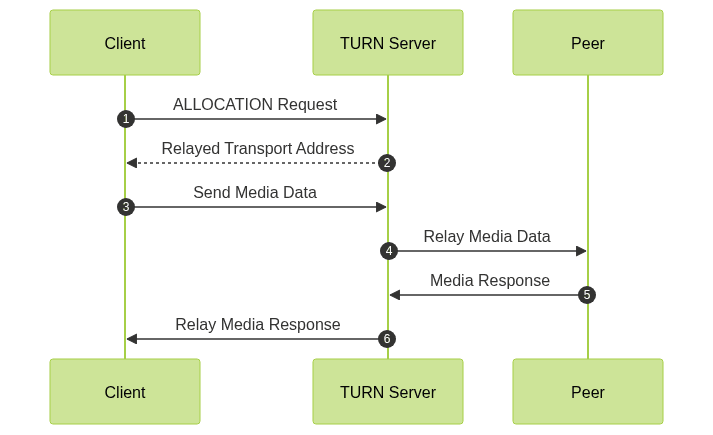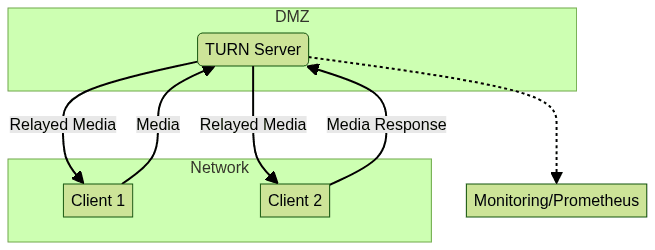Introduction to TURN Server
Real-time communication is at the core of modern web applications, from video conferencing to voice calls and collaborative tools. However, establishing reliable peer-to-peer (P2P) connections across the internet is often hindered by firewalls and Network Address Translation (NAT). This is where the TURN server comes into play. A TURN (Traversal Using Relays around NAT) server acts as a relay, ensuring seamless connectivity even in the most restrictive network environments. In 2025, with the rise of remote work and global collaboration, TURN servers are more crucial than ever for technologies like WebRTC, enabling secure and efficient NAT traversal for real-time communications.
What is a TURN Server?
TURN Server Explained
A TURN server is a specialized relay server designed to facilitate real-time communication between devices that cannot connect directly due to NAT or firewall restrictions. Rather than attempting direct peer-to-peer communication, clients send their media (like audio or video) to the TURN server, which then relays it to the intended recipient. This ensures that data transmission is possible even in highly restrictive network scenarios. For developers building modern communication platforms, integrating a
Video Calling API
can further streamline the process of enabling high-quality video and audio calls across diverse networks.Key Concepts: NAT, STUN, TURN
- NAT (Network Address Translation): Translates private IP addresses to public ones, often blocking direct P2P connections.
- STUN (Session Traversal Utilities for NAT): Helps discover the public IP address and port mappings, allowing direct connections unless the network is highly restrictive.
- TURN server: Acts as a media relay when STUN fails, ensuring connectivity by relaying all traffic between peers.
TURN servers provide a critical fallback mechanism for WebRTC and VoIP, guaranteeing robust connectivity when NAT or firewall traversal becomes challenging. For those developing real-time audio solutions, leveraging a
Voice SDK
can be invaluable in ensuring seamless voice communication even in complex network environments.How TURN Server Works
The TURN protocol (RFC 8656) enables clients to request the allocation of a relay address from the TURN server. Here’s a simplified workflow:
- The client sends an ALLOCATION request to the TURN server.
- The TURN server allocates a relayed transport address.
- The client uses this relay address for data transmission.
1# Pseudocode for TURN allocation request
2send_allocation_request(turn_server_url, credentials)
3receive_relayed_transport_address()
4# Use relayed address for media transport
5For those working on cross-platform applications, exploring technologies like
flutter webrtc
can help you build robust real-time communication features for both mobile and web.TURN Client-Server-Peer Interaction

TURN Server vs. STUN Server vs. VPN
Differences Between STUN and TURN Servers
While both STUN and TURN are essential for NAT traversal, their roles differ:
- STUN server: Enables clients to discover their public IP address, facilitating direct peer-to-peer connections when possible. Minimal server load since media is not relayed.
- TURN server: Required when direct connections fail due to strict NAT/firewall rules. The TURN server relays all media, increasing server bandwidth usage but ensuring reliability.
If you're building real-time communication features for Android, understanding
webrtc android
implementation details is crucial for seamless NAT traversal and optimal performance.TURN Server vs. VPN for NAT Traversal
A VPN (Virtual Private Network) tunnels all network traffic through a secure server, which can bypass NAT/firewall restrictions. However, VPNs are not optimized for real-time media and introduce additional latency. In contrast, a TURN server is purpose-built for media relay in real-time communications, offering lower latency, finer control, and better integration with WebRTC and VoIP applications.
Why and When Do You Need a TURN Server?
TURN servers are indispensable in scenarios where:
- Networks are highly restrictive (e.g., symmetric NAT, enterprise firewalls)
- Direct peer-to-peer connections fail (e.g., corporate or hotel Wi-Fi)
- Applications require reliable video/audio calls (e.g., WebRTC, VoIP, conferencing)
For developers looking to
embed video calling sdk
into their applications, TURN servers ensure that users can connect reliably regardless of their network environment.Benefits:
- Guarantees connectivity regardless of network restrictions
- Improves user experience for real-time communication
- Enhances security when combined with authentication and encryption
Limitations:
- Increased server bandwidth and operational costs
- Slightly higher latency due to media relay
Setting Up a TURN Server: Step-by-Step Guide
Choosing the Right TURN Server (Coturn and Alternatives)
The most popular open-source TURN server is Coturn, known for its robust feature set and active community. Alternatives include restund and proprietary cloud-based TURN services. When choosing, consider security, performance, scalability, and integration options with your application stack. If you are building with JavaScript, integrating a
javascript video and audio calling sdk
can help you quickly add real-time communication features that leverage TURN servers for reliability.Installing Coturn TURN Server (Linux & Docker)
On Ubuntu/Linux:
bash
sudo apt update
sudo apt install coturnUsing Docker:
bash
docker run -d --name coturn \
-p 3478:3478 -p 3478:3478/udp \
-v /etc/coturn:/etc/coturn \
instrumentisto/coturnThis launches the Coturn TURN server with mapped ports for UDP/TCP and persistent configuration storage.
Basic TURN Server Configuration
Coturn is configured via
/etc/turnserver.conf. Key settings include listening ports, authentication, and realm. Example configuration:1listening-port=3478
2fingerprint
3lt-cred-mech
4realm=example.com
5user=testuser:testpassword
6This sets up basic authentication and enables the long-term credential mechanism required for secure TURN operation.
Securing Your TURN Server
- Always enable TLS/DTLS for encrypted relay traffic.
- Use strong authentication (long-term credentials, TURN REST API).
- Regularly update your TURN server for security patches.
Advanced TURN Server Features and Integrations
TURN REST API and OAuth
Coturn supports dynamic credential generation via the TURN REST API, allowing stateless, time-limited credentials. This is particularly useful for web applications requiring secure, ephemeral access.
Example: Generating a TURN REST API credential
1import hmac
2import hashlib
3import base64
4import time
5
6key = b'shared_secret_key'
7username = str(int(time.time()) + 3600) # Expires in 1 hour
8hmac_digest = hmac.new(key, username.encode(), hashlib.sha1).digest()
9password = base64.b64encode(hmac_digest).decode('utf-8')
10print(f'Username: {username}, Password: {password}')
11Integrate with OAuth providers for single sign-on and improved security in enterprise deployments. For iOS developers, following a
callkit tutorial
can help you create seamless VoIP experiences that leverage TURN for reliable connectivity.Monitoring and Scaling TURN Server
- Integrate with Prometheus for real-time metrics and alerting.
- Use load balancers (e.g., HAProxy, NGINX) to distribute traffic across multiple TURN servers.
- Deploy TURN in the cloud for elastic scaling based on demand.
Integration with WebRTC and VoIP
TURN servers seamlessly integrate with WebRTC and SIP/VoIP stacks, acting as a fallback relay when direct peer-to-peer communication is not possible. For React Native developers, using a
react native video and audio calling sdk
can simplify the process of building robust cross-platform communication apps that work reliably across all network types.Optimizing TURN Server Performance
- Reduce latency: Deploy TURN servers geographically close to users.
- Bandwidth management: Monitor usage and scale horizontally as needed.
- Resource allocation: Tune
max-bps,total-quota, anduser-quotain configuration. - Security considerations: Enforce TLS, monitor logs, and avoid open relays to prevent abuse.
Common TURN Server Implementation Challenges
- NAT traversal issues: Some NAT types (e.g., symmetric) can be particularly challenging.
- Firewall restrictions: Ensure necessary ports (3478/UDP and TCP) are open.
- Authentication problems: Use strong, time-bound credentials and validate configuration.
- Debugging: Use verbose logging and tools like
tracerouteorwiresharkfor network diagnostics.
If you want to experience the benefits of a robust TURN server and integrated real-time communication tools,
Try it for free
and see how easy it is to get started.TURN Server Architecture: Visualizing the Flow

This diagram illustrates how a TURN server relays media between two clients, even when direct P2P is blocked, and how monitoring is integrated for operational visibility.
Conclusion: The Future of TURN Servers
As real-time communication continues to expand in 2025, the relevance of TURN servers grows. Emerging trends include managed cloud TURN services, increased security via OAuth, and integration with edge computing for ultra-low latency. TURN servers remain the backbone of reliable, secure, and scalable real-time applications across the globe.
For those looking to build advanced communication solutions, integrating a
Video Calling API
ensures your application is ready for the future of real-time connectivity.Want to level-up your learning? Subscribe now
Subscribe to our newsletter for more tech based insights
FAQ